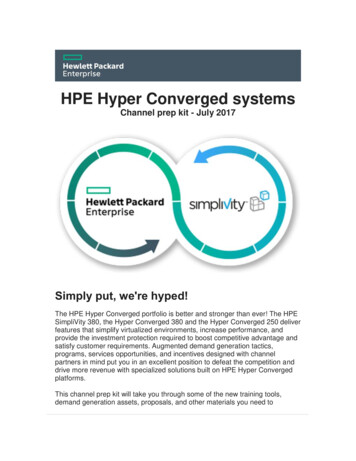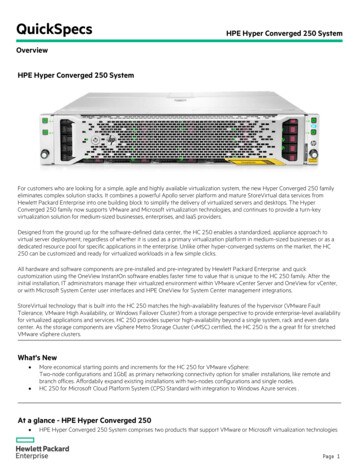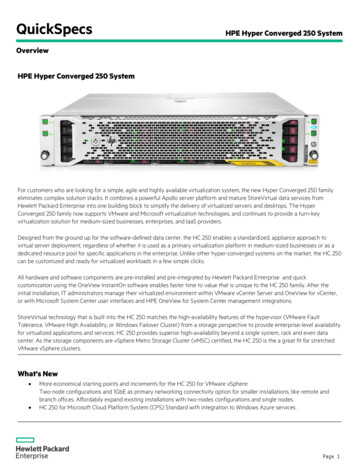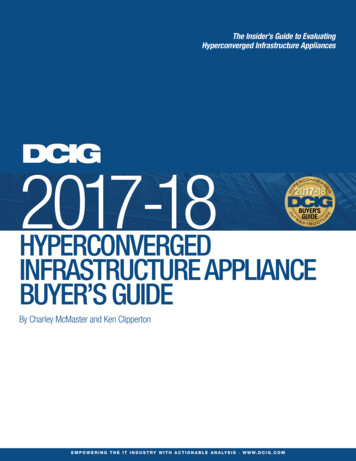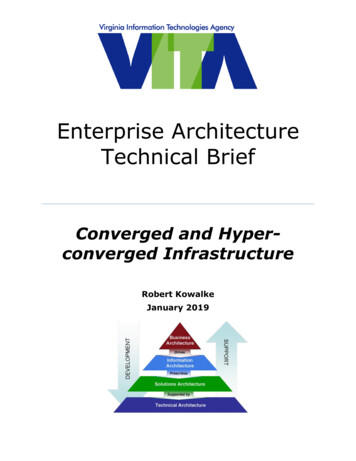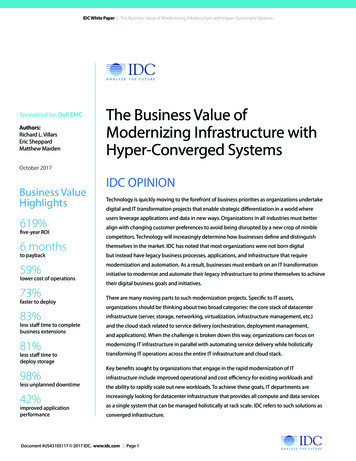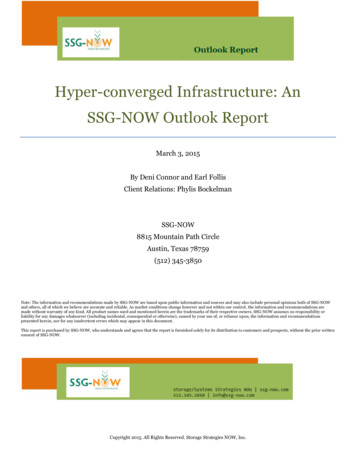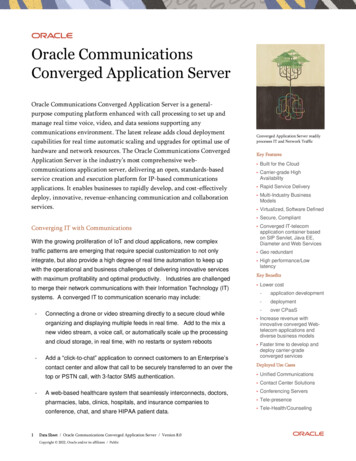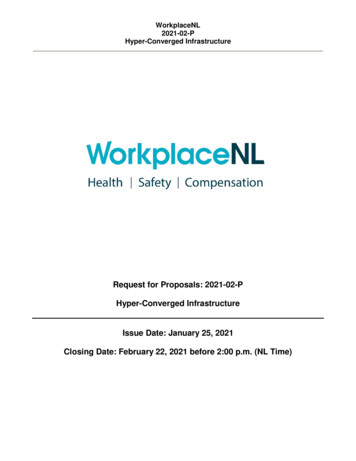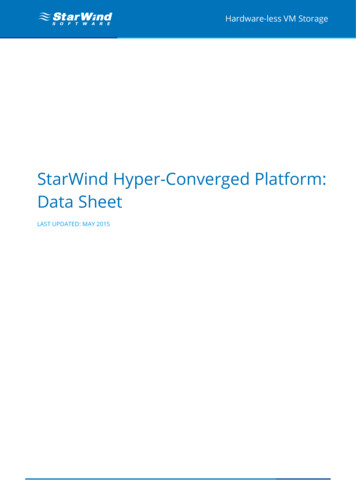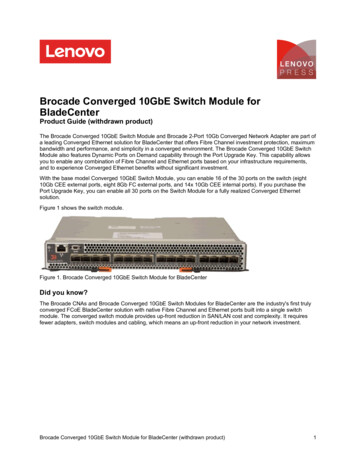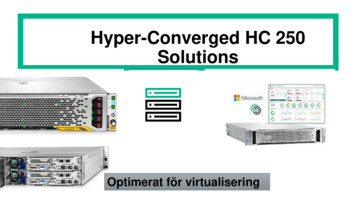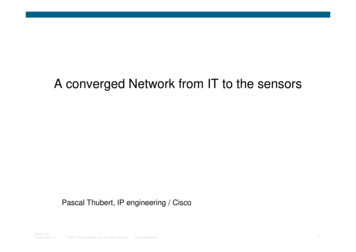
Transcription
A converged Network from IT to the sensorsPascal Thubert, IP engineering / CiscoSession IDPresentation ID 2007 Cisco Systems, Inc. All rights reserved.Cisco Confidential1
IntroductionSession IDPresentation ID 2007 Cisco Systems, Inc. All rights reserved.Cisco Confidential2
IntroductionWireless Sensor Networks have gained broad market acceptance inthe industry because of the values it provides. However, issues areraised when integrating wireless networks with tight response timeand availability constraints, into a IT network supporting a multipleapplications.This workshop discusses the mechanism to mitigate these issues.Session IDPresentation ID 2007 Cisco Systems, Inc. All rights reserved.Cisco Confidential3
Wireless Sensor Networks Scalable network of sensing and control devices Limited capabilities to scavenge and store power Limited CPU and memory Expensive listen and send - long deep sleep periods Ability to withstand harsh environmental conditions Autonomous and reliable (self forming self healing) Mobility of nodes - dynamic network topology Heterogeneity of nodes – new types of nodes Unattended operationSession IDPresentation ID 2007 Cisco Systems, Inc. All rights reserved.Cisco Confidential4
Past Communication Systems Analog Communications Point to point Dedicated wires Dumb transducers Hard wired, inflexible High cost of ownershipSession IDPresentation ID 2007 Cisco Systems, Inc. All rights reserved.Cisco Confidential5
Present Communication Systems Digital Communications HART Field buses IP/UDP networks Proprietary, dedicated Distributed intelligence Lower cost of ownershipSession IDPresentation ID 2007 Cisco Systems, Inc. All rights reserved.Cisco Confidential6
Future Communication SystemsWireless Sensor Networks Scalable Plug & Play High Availability VLANs and VRF Open Standards Shared infrastructure Converged networksPlant network Low and scalablecost of ownershipSession IDPresentation ID 2007 Cisco Systems, Inc. All rights reserved.Cisco Confidential7
The Problem(s) Today:Sensors are wired point to point / busses to the application serverHigh expectations in terms of security, reliability, latency, jitterManagement and maintenance are under plant/operations personnelTighter constraints for reactivity to problems than IT expectation Interconnection will share resources with the IT networkEnergy in the same radio bandsFrames in the same switching fabricPackets in the same IP network At that point, sensor operations depend on IT.Can IT react timely on connectivity problem?Can IT deliver acceptable quality for its services?Can IT protect its existing resources from new induced attacks?Session IDPresentation ID 2007 Cisco Systems, Inc. All rights reserved.Cisco Confidential8
Network HighAvailabilitySession IDPresentation ID 2007 Cisco Systems, Inc. All rights reserved.Cisco Confidential9
What Is High Availability?AvailabilityDPMDowntime Per Year (24x365)More than just revenue impactedRevenue loss99.000%100003 Days15 Hours36 MinutesProductivity loss99.500%50001 Day19 Hours48 MinutesImpaired financial performance99.900%10008 Hours46 Minutes99.950%50099.990%100Damaged reputationRecovery expenses4 Hours23 Minutes53 Minutes99.999%105 Minutes99.9999%130 SecondsDPM—Defects per MillionTo Achieve 5-9’s or betterseconds or even millisecondscountSession IDPresentation ID 2007 Cisco Systems, Inc. All rights reserved.Cisco ConfidentialIndustry SectorRevenue/HourRevenue/EmployeeHourEnergy 2,817,846 569Telecommunications 2,066,245 186Manufacturing 1,610,654 134Financial Institution 1,495,134 1,079Insurance 1,202,444 370Retail 1,107,274 244Transportation 668,586 107Average 1,010,536 20510
Traditional IT hierarchical Network DesignAccess Offers hierarchy – each layer has specificrole Modular topology - building blocksDistributionCoreSi Easy to grow, understand, andtroubleshootSi Creates small fault domains – Cleardemarcations and isolation Promotes load balancing and redundancySiSi Promotes deterministic traffic patternsDistributionAccess Incorporates balance of both Layer 2 andLayer 3 technology, leveraging the strengthof bothSiSi Utilizes Layer 3 Routing for loadbalancing, fast convergence, scalability,and controlBuilding BlockSession IDPresentation ID 2007 Cisco Systems, Inc. All rights reserved.Cisco Confidential11
High Availability Protocols Layer 3 routing protocolsNon Stop Forwarding (NSF)Stateful Switch Over (SSO) Layer 2 redundancy—spanning treePVST - STP (802.1D-1998)Rapid PVST - RSTP (802.D-2004) Trunking protocols—(isl/.1q) Unidirectional link detectionHSRP Load balancingEtherchannel link aggregationCEF equal cost load balancingRoutingSpanningTree First hop redundancy protocolsVRRP, HSRP, and GLBPSession IDPresentation ID 2007 Cisco Systems, Inc. All rights reserved.Cisco Confidential12
Guaranteedbandwidth andQOSSession IDPresentation ID 2007 Cisco Systems, Inc. All rights reserved.Cisco Confidential13
Why QoS in the Production Site QoS does more than just protect Real Time data like sensors and voice For "best-effort" traffic an implied "good faith" commitment that there are atleast some network resources available is assumed Need to identify and potentially punish out of profile traffic(potential worms, DDOS, etc.) Scavenger class is an Internet-2 Draft Specification CS1/CoS1AccessDistributionReal TimeReal TimeDataScavengerSession IDPresentation ID 2007 Cisco Systems, Inc. All rights reserved.CoreDataScavengerCisco Confidential14
Best Practices—Quality of Service Must be deployed end-to-endto be effective; all layers playdifferent but equal roles Ensure that mission criticalapplications are not impactedby link or transmit queuecongestionSiSiLayer 3 EqualCost Link’sSiSiSiSiSiSiWANSiSiLayer 3 EqualCost Link’s Aggregation and ratetransition points must enforceQoS policies Multiple queues withconfigurable admissioncriteria and schedulingare requiredSiSiSiSiData CenterInternetEnd to End QoSSession IDPresentation ID 2007 Cisco Systems, Inc. All rights reserved.Cisco Confidential15
FlowIsolationSession IDPresentation ID 2007 Cisco Systems, Inc. All rights reserved.Cisco Confidential16
What is Network Virtualization?Virtualization: 1 to Many or Many to 1One network supports many virtual networksWireless Sensor NetworkOffice DomainVirtualVirtualOperations Control DomainVirtualActual plant LANSession IDPresentation ID 2007 Cisco Systems, Inc. All rights reserved.Cisco Confidential17
Virtualization Required Across All IndustriesManufacturingHealthcareAutomation ofProduction PlantsIndividual“Hotel” Servicesfor PatientsIntegration ofSales Sites,Suppliers andPartnersVideo SurveillanceSession IDPresentation ID 2007 Cisco Systems, Inc. All rights reserved.Isolated medicalNetworks forRecords,ServicesGovernmentShared Buildingsand Facilitiesacross differentAgencies:PoliceFire DepartmentTax AdministrationCisco Confidential18
Virtualized Network DevicesSwitch virtualization—VLANsRouter virtualization—Virtual Routing/Forwarding (VRFs)802.1q, GRE, LSP,Physical Int, Others802.1q or OthersVRFVRFGlobalLogical orPhysical Int(Layer 3)Logical orPhysical Int(Layer 3)Session IDPresentation ID 2007 Cisco Systems, Inc. All rights reserved.Cisco Confidential19
Network Virtualization ArchitectureAccess ControlPath IsolationBranch - PlantWAN – MAN - PlantGREServices EdgeData Center – InternetEdge - PlantMPLSVRFsFunctionsAuthenticate client (user,device, app) attempting togain network accessAuthorize client into aPartition (VLAN, ACL)Deny access tounauthenticated clientsSession IDPresentation ID 2007 Cisco Systems, Inc. All rights reserved.Maintain traffic partitioned overLayer 3 infrastructureTransport traffic over isolatedLayer 3 partitionsMap Layer 3 Isolated Path toVLANs in Access and ServicesEdgeCisco ConfidentialProvide access to services:SharedDedicatedApply policy per partitionIsolate Applicationenvironments if necessary20
SummaryInternetPlantA Converged network Wireless Sensor networkCohabiting Integrated withSiSi Managed IT network–802.11/ Ethernet network–Hierarchical IP architectureAccess, distribution, coreSession IDPresentation ID 2007 Cisco Systems, Inc. All rights reserved.Cisco ConfidentialWireless SensorNetwork21
Promotes load balancing and redundancy Promotes deterministic traffic patterns Incorporates balance of both Layer 2 and Layer 3 technology, leveraging the strength of both Utilizes Layer 3 Routing for load balancing, fast convergence, scalability, and control
